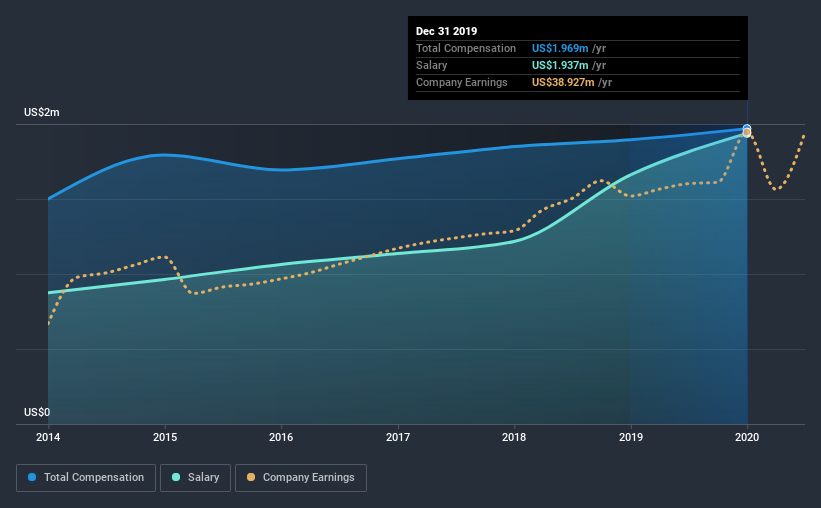How Much Does Hingham Institution for Savings' (NASDAQ:HIFS) CEO Make?

Robert Gaughen became the CEO of Hingham Institution for Savings (NASDAQ:HIFS) in 1993, and we think it's a good time to look at the executive's compensation against the backdrop of overall company performance. This analysis will also look to assess whether the CEO is appropriately paid, considering recent earnings growth and investor returns for Hingham Institution for Savings.
View our latest analysis for Hingham Institution for Savings
How Does Total Compensation For Robert Gaughen Compare With Other Companies In The Industry?
Our data indicates that Hingham Institution for Savings has a market capitalization of US$389m, and total annual CEO compensation was reported as US$2.0m for the year to December 2019. That's a fairly small increase of 3.9% over the previous year. In particular, the salary of US$1.94m, makes up a huge portion of the total compensation being paid to the CEO.
In comparison with other companies in the industry with market capitalizations ranging from US$200m to US$800m, the reported median CEO total compensation was US$1.2m. Accordingly, our analysis reveals that Hingham Institution for Savings pays Robert Gaughen north of the industry median. What's more, Robert Gaughen holds US$13m worth of shares in the company in their own name, indicating that they have a lot of skin in the game.
Component | 2019 | 2018 | Proportion (2019) |
Salary | US$1.9m | US$1.7m | 98% |
Other | US$32k | US$233k | 2% |
Total Compensation | US$2.0m | US$1.9m | 100% |
Speaking on an industry level, nearly 59% of total compensation represents salary, while the remainder of 41% is other remuneration. Investors will find it interesting that Hingham Institution for Savings pays the bulk of its rewards through a traditional salary, instead of non-salary benefits. If salary dominates total compensation, it suggests that CEO compensation is leaning less towards the variable component, which is usually linked with performance.
A Look at Hingham Institution for Savings' Growth Numbers
Hingham Institution for Savings has seen its earnings per share (EPS) increase by 16% a year over the past three years. Its revenue is up 16% over the last year.
Shareholders would be glad to know that the company has improved itself over the last few years. This sort of respectable year-on-year revenue growth is often seen at a healthy, growing business. We don't have analyst forecasts, but you could get a better understanding of its growth by checking out this more detailed historical graph of earnings, revenue and cash flow.
Has Hingham Institution for Savings Been A Good Investment?
With a total shareholder return of 5.7% over three years, Hingham Institution for Savings has done okay by shareholders. But they probably wouldn't be so happy as to think the CEO should be paid more than is normal, for companies around this size.
In Summary...
Hingham Institution for Savings pays its CEO a majority of compensation through a salary. As previously discussed, Robert is compensated more than what is normal for CEOs of companies of similar size, and which belong to the same industry. However, we must not forget that the EPS growth has been very strong over three years. We also think investor returns are steady over the same time period. So, considering the EPS growth we do not wish to criticize CEO compensation, though we'd recommend further research on management.
If you think CEO compensation levels are interesting you will probably really like this free visualization of insider trading at Hingham Institution for Savings.
Important note: Hingham Institution for Savings is an exciting stock, but we understand investors may be looking for an unencumbered balance sheet and blockbuster returns. You might find something better in this list of interesting companies with high ROE and low debt.
This article by Simply Wall St is general in nature. It does not constitute a recommendation to buy or sell any stock, and does not take account of your objectives, or your financial situation. We aim to bring you long-term focused analysis driven by fundamental data. Note that our analysis may not factor in the latest price-sensitive company announcements or qualitative material. Simply Wall St has no position in any stocks mentioned.
Have feedback on this article? Concerned about the content? Get in touch with us directly. Alternatively, email editorial-team@simplywallst.com.

